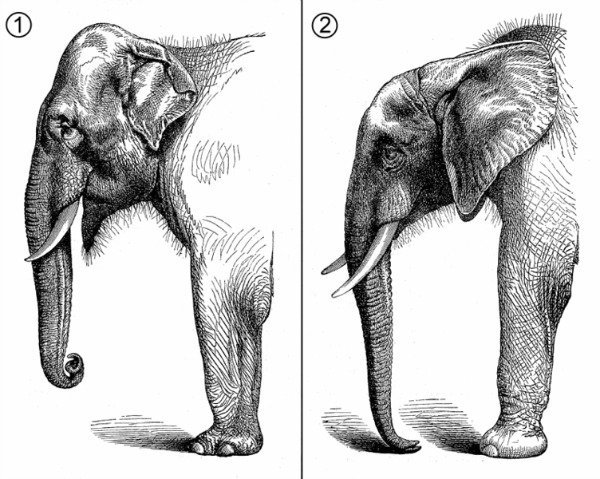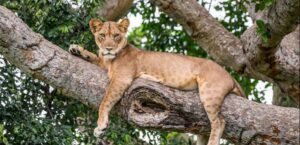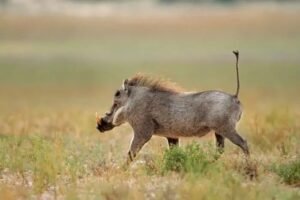
SOME INTERESTING FACTS ABOUT AFRICAN ELEPHANTS.
Is it a fact that the African elephant is a highly social African animal?
Yes – African elephants are indeed very social. The basic stable social unit among African elephants is a group of closely related adult females with their young of various ages.

The movements of a family group are directed by the oldest and biggest cow (often referred to as the matriarch). This would typically be a female that have accumulated her necessary experience over 30 to 40 years.
This female will make most of the decisions about where and when the herd forages, drinks and rests. If these old cows are shot during elephant hunting their knowledge is lost and the rest of the group will wander aimlessly.

Males sometimes form small unstable bachelor groups. Two or three younger apprentices known as askaris may accompany an old male. Family groups and males may gather into herds several hundred strong. If their usual food and water supplies dwindle elephants will move long distances to reach more favorable conditions.
The members of an African elephant family group take good care of one another. If one of them is sick or injured, others will stay with it to defend it. The calves get especially close attention. The adults help them climb steep banks and will protect them from predators.
How dangerous is a charging elephant?
If an elephant goes on a serious charge it is quite capable of killing rhino and hippo, and of wrecking vehicles.
Would you be able to tell the mock charge from an elephant from a serious charge?
How do elephants use their trunks?

The trunk is essentially a modified nose made of muscle. The elephant trunk has evolved over time and can be used for various functions. It is basically a modified nose. This trunk alone contains thousands of different muscles. With this tool an elephant can do a variety things from picking up a small maroela fruit or berries to picking up a massive tree trunk.
When you look closely at the trunk you will notice hairs on it which makes it sensitive to touch.
It is believed that an elephant can distinguish smells several hundred times better than any dog with its trunk.
The trunk is important for social interactions among the herd individuals and used for caressing – especially between mother and calf.
Other social interactions may include greeting and demonstrations of dominance or submission via various trunk postures.
What does an elephant use its tusks for?

Tusks are mainly used to dig for specific food items like tree roots and also for defense. In encounters during fights for dominance they can use tusks to stab opponents. Elephant tusks never stop growing. Older elephants will therefore have the biggest tusks which makes them the priority targets of ivory poachers.
What are the differences between the African and Asian species of elephants?

Asian elephants African elephant
Crumpled from the front to the back.
Notice the humped area on the top of the head.
The forehead is dented.
Convex or straight neck.
Weighs 3000 – 6000 kg.
Not crumpled from the front to the back.
No humped area on the top.
Forehead is not dented.
Concave neck.
Weighs 4000 – 7000 kg.
Also notice –
The African elephants have extremely large ears that can be likened to the shape of the African content. Similarly the smaller Asian elephant ears can be compared to the shape of the Indian subcontinent.
In the case of the African specie both males and females have visible tusks. With the Asian specie only males have obvious external tusks.
The females have small tusks that may or may not protrude far enough to be visible. The Asian specie has one semi-prehensile “finger” to its trunk while the African specie has two of them.

One sign that an elephant is stressed is that its tail will become stiff and pointed to one side.
Elephant that swings their tales from side to side are trying to keep the flies off their body and this usually means it is happy and relaxed.
How do elephants breed?
Unlike hippos that rely on the buoyancy effect of water for copulation, the African elephant bull does mount the female in the conventional manner on land.
Elephants breed throughout the year. Males younger than 25 years old are unable to compete for access to females on heat. From the age of 25 bulls periodically goes into musth as their testosterone levels rise up to six times the usual level. At this time they walk with their head high and they become very aggressive towards other males, which avoid them.

Musth bulls will fight to the death over access to females. In the restricted areas musth bulls kill young males often enough to slow the growth of the population.
Younger members of the herd act as nannies to calves but all family members takes full responsibility for the protection of the calves. Between 25 and 35 years they mate, in the female oestrus period when conception is unlikely.

Males older than 35 years guard and mate with females at the most favorable time for fathering a calf. Mating takes place at about 8 hour intervals. Elephants have a longer pregnancy than any other mammal—almost 22 months. Cows usually give birth to one calf every two to four years.
What are some interesting baby African elephant facts?
At birth, an elephant calf already weighs some 200 pounds (91 kilograms) and stands about 3 feet (1 meter) tall. They can stand and walk within an hour of birth. The calf begins to nurse within a few minutes, using its mouth, not its trunk. An elephant calf is suckled for at least two years and even after weaning it remains closely bonded to its mother. When a calf attempts to suck from lactating females other than its mother it will be repelled – usually with a vigorous slap from the cow trunk. If a calf loses its mother the other females in the group will take care of it.

Young elephants play by splashing and spraying each other with water and mud. They also wrestle with their trunks and practice fighting in pushing competitions. They also mock-charge other species such as antelope.











